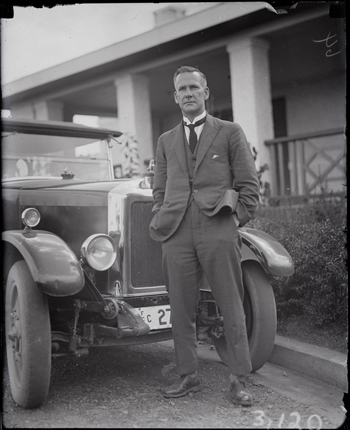About Mildenhall
WJ Mildenhall’s legacy is invaluable. His photographs document most aspects of the foundation era in Canberra’s history as the new capital city of Australia. Both as historical documents and as works of art, the Mildenhall photographs held by the National Archives of Australia, and a smaller collection held by the National Library of Australia, are of great significance to Australia. However commercial rivalry ended his career as the photographic chronicler of Canberra’s early years.

Royal Visit, May 1927 - Mr Mildenhall with his Armstrong Siddeley motor car Registration Number 27
William James Mildenhall (1891–1962) joined the Commonwealth Public Service soon after it was established, in 1906. At first based in Melbourne, he later worked in the payments area of the Trans-Australian railway in the then Department of Works and Railways, in Port Augusta, South Australia, where “he was one of the small band of officials working under abnormal conditions, and on several occasions made his rounds on a camel”. [Canberra Times, 7 September 1951] This was one of the first great public works projects embarked on by the Commonwealth, and one of the reasons why Western Australia had agreed to federate with the rest of Australia in 1901.
Mildenhall went to Canberra in 1921, taking up the position of Paymaster and Collector of Public Monies in the department's Canberra office, and in 1926 was appointed as the official photographer and information officer of the Federal Capital Commission, formed to oversee Canberra’s development. Later he assisted with a Royal Australian Air Force aerial survey of northern Australia. During the war years he ran Canberra’s petrol rationing scheme and then worked in the Ministry for Munitions. He retired in 1951, after 45 years as a public servant.
An enthusiastic amateur photographer, his first work for the government was done in his own time, in return for the cost of photographic supplies such as plates and developing chemicals. He had pointed out to his superiors that: “although there are two departmental cameras held by officers at Canberra, neither of the officers have had experience in outdoor work”. Instead, an officer from the new Military College at Duntroon had to be brought in when needed. “I have had ten years experience in all branches of photography and have specialised in outdoor work under all weather conditions”, he said. [Mary Hutchison, Developing Images: Mildenhall’s photographs of early Canberra. National Archives of Australia, Canberra, 2000, p. 1]
His career as an official photographer was brief. It ended in 1935 when a local commercial photographer questioned the appropriateness of a public servant on an official salary having an apparent monopoly of government work in Canberra, and the complaint was upheld. Fortunately, however, his unfettered work for more than a decade in Canberra coincided with the construction of the Provisional Parliament House and the important first stages of the city’s growth from village status. Without his enterprise and skill, much of this would be undocumented in pictorial terms.
As one historian has commented, “one of the things that make these photographs so valuable is that they show the builders as well as the buildings... Through them we can appreciate the experience of building not just ‘a whole new city’ but a new domestic and community life”. [Mary Hutchison, Developing Images: Mildenhall’s photographs of early Canberra. National Archives of Australia, Canberra, 2000, pp. 2–3]